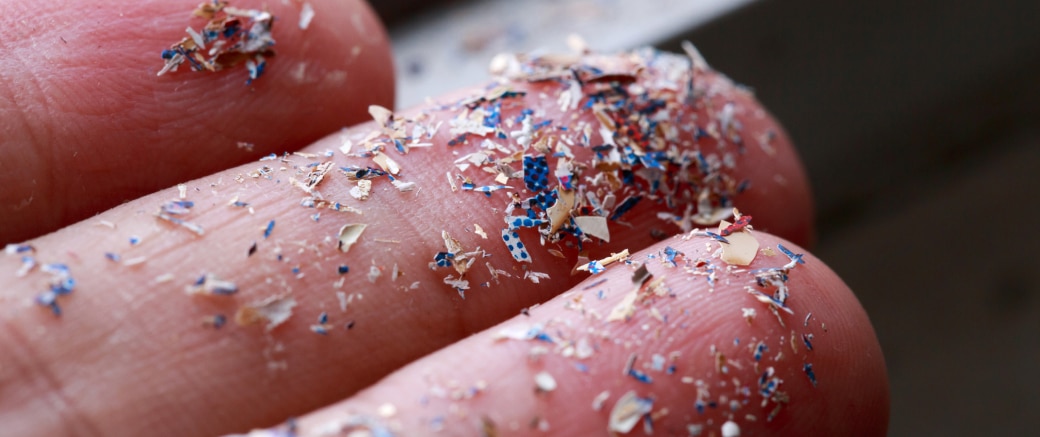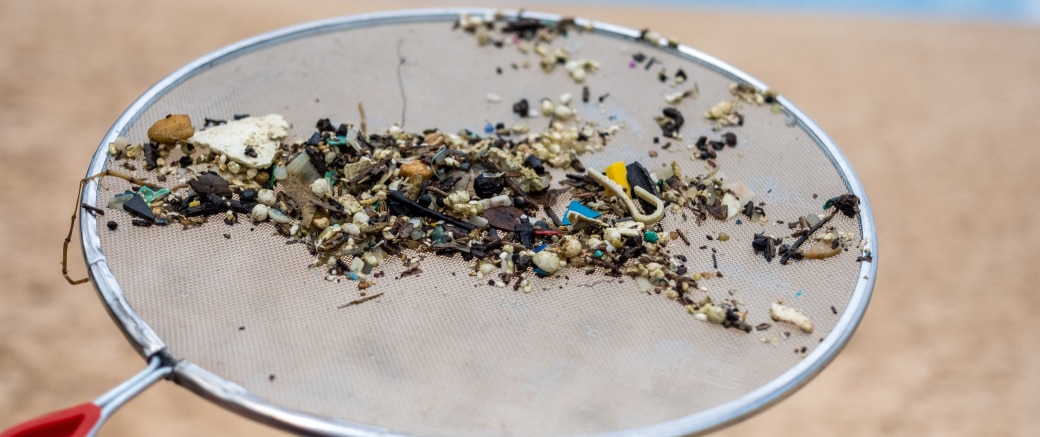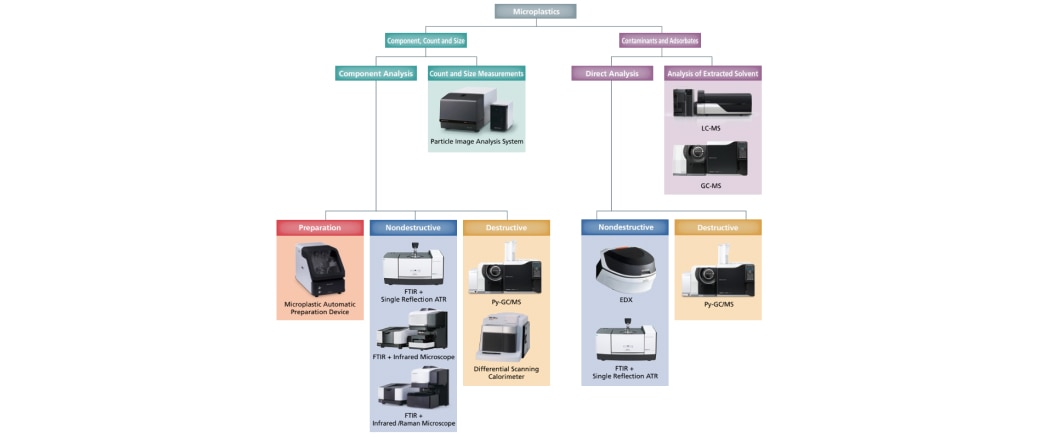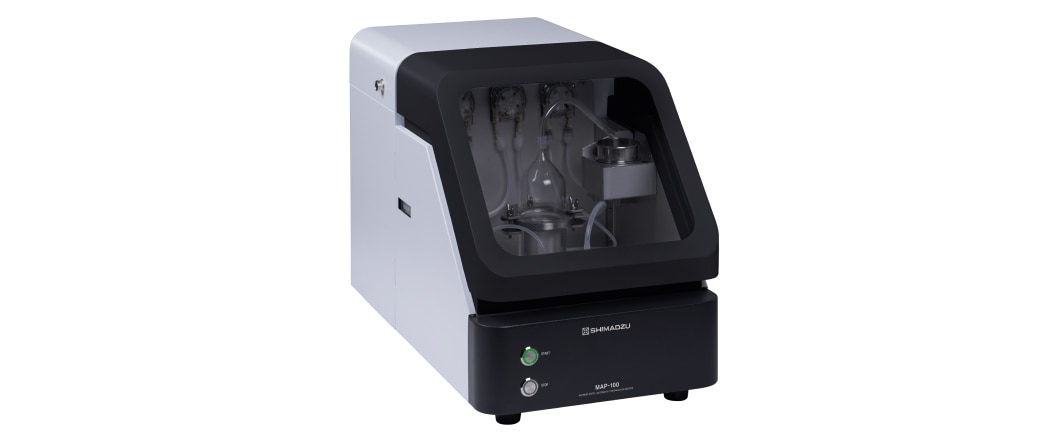Shimadzu's Solutions To Microplastics Analysis

What Are Microplastics?
Microplastics are minute pieces of plastic with diameters ranging from a few micrometers to a couple of millimeters. In recent years, microplastics have become a global marine environmental issue since they may adversely affect coastal and marine ecosystems and potentially harm the health of human beings.
Though there is no strict definition of the term “microplastics,” it generally refers to tiny pieces of plastic less than 5 mm in size that are dispersed in rivers, lakes, oceans, and other areas of the environment.
There are basically two types of microplastics. One type is “primary microplastics,” which are plastics originally made as very small pieces that are used as raw materials for a wide variety of products. One example is “microbeads,” which are used in facial cleaning products or industrial polishing agents.
The other type is “secondary microplastics,” which are derived from plastic waste that is released into the environment and then broken down into small pieces by external factors, such as the physical effects of ultraviolet rays or waves, and temperature changes.
The problem with microplastics is not only based on concerns about how the plastic material itself can affect the natural environment or organisms, but also how the whole food chain of organisms ingesting hazardous chemical substances adsorbed to microplastics can affect the overall ecosystem.
In this article, Shimadzu explores the complexities of microplastics and provides practical solutions to address this evolving and crucial area of concern. Learn more about microplastics, how they can be analyzed, and our game-changing product - Microplastics automatic preparation device (MAP-100), the world’s first automated extraction and recovery process for microplastics analysis.
Potential Effects of Microplastics

Whether it is primary or secondary microplastics, their impact on the marine environment is becoming a serious problem. When plastics are swept out into the sea, they degrade into microplastics through physical wear and ultraviolet light. These microplastic pieces are then inadvertently consumed by marine animals.
In addition to the risk of physical obstruction or damage to the digestive organs and digestive tracts in marine animals, the additives (such as flame retardants, plasticizers, and antioxidants) contained in the microplastics themselves, or the harmful substances (such as PCBs and DDT) which adhere to them within the environment, are accumulated in the organs and gradually become biomagnified.
Moreover, there is a concern that microplastics consumed by marine animals will have an impact on human health as they pass through the food chain. While the main focus is on pollution in oceans and other environmental water, there are also reports that microplastics have been detected in the air. Currently, however, the impact of microplastics on human health is not sufficiently understood, and further investigation is required.
Workflow Analysis For Microplastics
With regards to the investigation and analysis of microplastics, unified measures have not been established worldwide, so there are difficulties when comparing and evalutating data, making the unification of guidelines desirable. As an ISO Commission member, Shimadzu is involved in the standardization of methods.
Nonetheless, at present, in order to evaluate environmental contamination by microplastics and the risks involved, research agencies and regional governments in countries around the world are promoting monitoring based investigations. Such investigations target diverse samples, not only from rivers, oceans, and other environmental waters, but also from tap water, soil, and in vivo. In line with the various targets, investigative guidelines summarizing sampling, pretreatment, and measurement methods are created separately by the various countries and institutions.
Workflow for Selecting an Analysis and Measurement Method
Microplastic analysis and measurement methods differ depending on what is being measured. A selection flowchart is shown below. Component analysis can be performed easily and nondestructively using a Fourier transform infrared spectrophotometer, an infrared microscope, or an X-ray fluorescence spectrometer. On the other hand, measurements using pyrolysis gas chromatography mass spectrometry, for example, will destroy the sample by pyrolysis, but such methods allow analysis of the interior of materials, and enable the simultaneous analysis of mixed samples containing multiple components of different types of plastics.

Potential Issues In Microplastics Analysis
Generally, when discriminating between plastics, a spectrum is obtained using a Fourier transform infrared (FTIR) spectrophotometer or Raman spectrophotometer, and is then compared with a library containing the spectra for standard plastic items.
However, the shape of the spectrum for a degraded plastic differs from the spectra of a standard. Accordingly, the spectrum will not match anything in commercially available plastic libraries, which makes identification and qualitative analysis difficult.
Shimadzu’s plastic analyzer contains an infrared spectral library of plastics degraded by UV rays and heat, enabling dramatic improvements to quantitative accuracy in microplastics analyses. Additionally, very small microplastics on the order of a few μm in size can be qualified using an Infrared/Raman microscope (AIRsight). Note that AMsolution, the software that controls our Infrared microscope and Infrared/Raman microscope, is equipped as standard with a length measuring function capable of measuring microplastics particle size.
Introducing MAP-100, An Automatic Preparation Device for Isolating Microplastics in Environmental Surface Water

To accurately analyze microplastics in aqueous samples, an essential step is to isolate the particles from other components in the sample. This process normally involves digestion and separation steps.
The MAP-100 automates the typical steps needed to isolate microplastics. This improves the reproducibility of the analytical workflow, enables lab technicians to focus on other tasks, and makes handling of reagents safer.
Key Benefits
- Labor Savings: Automating the complicated preparation process significantly reduces the number of man-hours required.
- Reproducibility: Manual tasks by the operator are reduced, enabling highly reproducible preparation. This improves accuracy when comparing data across analysts and laboratories.
- Safety: Simplified handling of reagents by operators.
For More Resources: Register On-Demand Session on Digital Classrooms
Explore Shimadzu’s innovative solutions to fast-track microplastics research using advanced and automated workflows.
In the first part of the session, we will explore the analysis of microplastics in oceans and other environmental waters using Fourier-Transform Infrared Spectroscopy (FTIR) and Infrared/Raman microscope. Learn how these tools, combined with our innovative automated sample preparation device and the resourceful degraded plastics libraries, can accurately identify and characterize microplastics, contributing to a more profound comprehension of their prevalence in aquatic ecosystems.
In the second part, we'll unveil an automated workflow leveraging Pyrolysis-Gas Chromatography/Mass Spectrometry (Pyrolysis-GCMS). This cutting-edge approach streamlines the identification and quantitative analysis of microplastics in environmental samples, increasing efficiency while maintaining accuracy.
Learning Objectives:
- Explore Shimadzu’s analytical tools for microplastics research and analysis.
- Understand use of FTIR and Infrared/Raman microscopy in microplastics identification.
- Learn how to streamline identification and quantification of microplastics using Pyrolysis-GCMS.
- Discover how automated workflows enhance efficiency in microplastics analysis in environmental samples.
Thank you for reading! If you are interested in our updates, stay connected with us via our Newsletters, Digital Classrooms, LinkedIn, Facebook, or Youtube.


